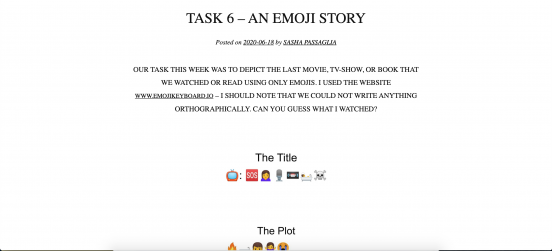I've really enjoyed the blog space approach in this course. Completing a weekly task is only half the fun. The rest comes from browsing through and engaging with other people's posts. The variety in our approaches and thoughts on the same assignment never fails to amaze and intrigue me, and I always close each window with my mind spinning with new ideas. For my linking assignment, I have selected posts that I found myself thinking about long after reading and commenting on them.
Link 3
For my third link, I went back to Sasha Passaglia’s Week 6 post on emoji stories. The original can be viewed below.
Post Summary
Sasha’s post began with a small introductory disclaimer, followed by her emoji story which she divided into title and plot. After that, she had a three paragraph discussion about her approach to this emoji story which included focuses on why she selected the media she did, and
Reflection
Upfront admission: I still don’t know what her media is, but that is probably due to me not watching much TV. Right, now thats out the way, let’s move on.
Sasha said a few things that resonated with me and that I had also done with this task. She decided she wanted to be “truthful” and select media she had genuinely consumed recently. She also had options which she contemplated before settling on her final choice. Sasha was also sensitive to the diversity in how people may use or interpret emojis, and how individual associations with certain symbols may hinder clear communication of ideas. However, she focused on an aspect of emoji-translation that never occurred to me: using them syllabically.
If the viewer doesn’t understand the expression I might be using, let’s say a multi-syllable word broken down into two emojis; i.e. Spider emoji, Man emoji, for Spiderman, then the emojis are rendered useless for this particular viewer.
Whilst this did not turn out to be a successful approach for making emojis semiotically successful, it did prompt some ideas for me about how text is multi-layered and how combinations of different types of text are important in the construction and communication of meaning. The creator of emojis said that they were meant to help “express abstract ideas in a single character”. Now, this task gave us all insight into the fact that whilst emojis can do this successfully when combined with written text, they are not necessarily great at conveying clear meaning when combined with one another. In order to communicate a story successfully we had to use emojis in groups and decide what they would represent. This meant understanding how we see them whilst guessing how others might interpret this as well. Sasha stated that she:
In the end, I opted for a combination of ideas and words for both the Title and the Plot.
The standout word for me in this statement is “combination”. It may seem self-explanatory when said, but I see all text as a combination of ideas and words. The way we order words, what words we choose, our emphasis on certain words (through speech patterns, grammar, or punctuation), and what words we omit all assist in conveying our ideas. For this task, selecting the combination of ideas and words was a successful approach to using emojis because it helped overcome some of the limitations of the emoji-text we were using. However, the lack of combining emojis with other texts made them very challenging to interpret.
This reminded me of our voice-to-text task, where our words were often no longer combined with grammar and became a lot harder to read and understand because of that limitation. It seems that in order to make sense, words and ideas need to be conveyed in combination with something else. Written text requires grammar, syntax, and punctuation. Spoken text require pauses, emphasis, and body language. Emoji text requires a surrounding conversation, or words, or a pre-determined shared meaning. It seems that text, as a term, should never be thought of as a singular set of lexical items. It is never just words. It is always a combination of representations (such as words, grammar, icons, punctuation) and ideas (shared concepts, meanings, cultures, patterns, norms). It makes me wonder whether there are any instances in which ideas and words are separated, or where one aspect of text can stand alone for effective communication. Perhaps poetry could be considered one of the spaces where these rules are bent.
My head is still spinning, and I’m trying to gain a little more clarity on what exactly I mean, but there is so much to think about in the realm of words, ideas, combinations, and meaning! Would love to hear your thoughts in the comments. Maybe we can wade through this together and come up with some insights on the other side.
Closing Media
This discussion had me go down a huge YouTube tunnel, and the following videos are nice resources to prompt more musing and ideas around these thoughts.
